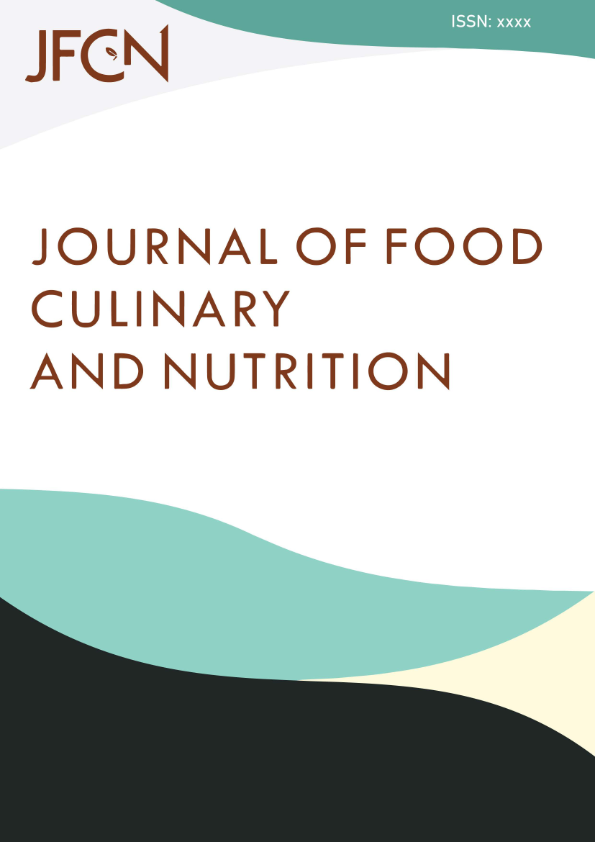STUDY OF PECTIN CAPABILITY TO ADSORB Cd(II) IN AQUEOUS SOLUTION AND ITS SELECTIVITY WITH Zn MINERAL
Abstract
The polluted environment will lead to food chain contamination and risk to human health. As an eco-friendly adsorbent, pectin has been studied to adsorb Cd(II) and other heavy metal ions effectively. It has the potential to prevent heavy metal ions absorption but might interfere mineral absorption during the digestive process. This research aimed to analyze the ability of pectin to adsorb Cd(II) ions in multi metal solutions at stomach condition (pH 2) and small intestine condition (pH 6) with competition to other mineral Zn as essential nutrient. About 0.2 grams of pectin was dispersed into multi metal solution 32 ppm of Cd(II) and 1 ppm of Zn(II) in pH 2 and 6. Metal ions were analyzed using Atomic Absorption Spectroscopy (AAS). The result proved that pectin can adsorb 0.32 ppm (29.03%) of Zn(II) and 13.8 ppm (38.87%) of Cd in pH 2. Pectin was more selective to adsorb Zn(II) in pH 6 where minerals were absorbed. This analogue result also provided distribution coefficient (D) which lead to the increasing of pectin selectivity towards Zn(II) with increasing of pH. The very high performance of pectin was selective for Cd in pH 2 αCd/Zn of 1.55.
Keywords
Full Text:
PDFReferences
Arifiyana, D and Devianti, V.A. (2021). BIOSORPTION OF Fe (II) IONS FROM AQUEOUS SOLUTION USING KEPOK BANANA PEEL (Musa acuminate). KPK (JURNAL KIMIA DAN PENDIDIKAN KIMIA), 6(2), 206-214.
Briffa, J., Sinagra, E., & Blundell, R. (2020). Heavy metal pollution in the environment and their toxicological effects on humans. Heliyon, 6(9), e04691.
Ekowati, G. W., & Rahmayanti, M. (2019). Kajian Desorpsi Zat Warna Indigosol Blue Dari Adsorben Humin Hasil Isolasi Tanah Gambut Riau, Sumatera. Analit: Analytical and Environmental Chemistry, 4(2), 68-75
Harumi, M., Santosa, S.J., and Nuryono. (2019). Recovery of Au(III) from printed circuit board waste by chitosan/SiO2 coated on iron sand magnetic material, Mater. Today: Proc., 19, 1101–1110
Hastuti, B., and Totiana, F. (2017). GREEN ADSORBENT OF PECTIN FROM CARROT PEEL AND ITS APPLICATION AS REMOVAL OF PB(II). International Journal of Advances in Science Engineering and Technology,5(4), 4-7.
Hezbullah, M., Sultana, S., Chakraborty,A.R., and Patwary, M.I. (2016). Heavy metal contamination of food in a developing country like Bangladesh: An emerging threat to food safety. J. Toxicol. Environ. Heal. Sci., 8(1), 1–5
Khan, N.V., Vinh, T.D., kubo, K., Kinh, K.T., Vinh, D.C. (2015). Assessment Of Lead And Cadmium Contamination By Sediments And Bivalve Species From The Estuaries in Da Nang City, Vietnam. Journal of Environmental Science for Sustainable Society, 6, 1
Kosolsaksakul, P., Farmer, J. G., Oliver, I. W., & Graham, M. C. (2014). Geochemical associations and availability of cadmium (Cd) in a paddy field system, northwestern Thailand. Environmental Pollution, 187, 153-161.
Koziolek, M., Grimm, M., Becker, D., Iordanov, V., Zou, H., Shimizu, J., Wanke, C., Garbacz, G., & Weitschies, W. (2015). Investigation of pH and Temperature Profiles in the GI Tract of Fasted Human Subjects Using the Intellicap® System. Journal of Pharmaceutical Sciences, 104(9), 2855–2863. https://doi.org/10.1002/jps.24274
Lessa, E.F., Medina, A.L., Ribeiro, A.S., Fajardo, A.R. (2020). Removal of multi-metals from water using reusable pectin/cellulose microfifibers composite beads Arabian Journal of Chemistry, 13, 709–720
Lopez, L.P.C., Macena, M., Esteves, B., Guine, R.P.F. (2021). Ideal pH for the adsorption of metal ions Cr6+, Ni2+, Pb2+ in aqueous solution with different adsorbent materials. Open Agriculture. 6(1), 115-123
Mezynska, M., & Brzoska, M. M. (2018). Environmental exposure to cadmium—A risk for health of the general population in industrialized countries and preventive strategies. Environmental Science and Pollution Research, 25(4), 3211-3232.
Napitupulu, M., Walanda, D.K., Natakusuma, Y., Basir, M., Mahfudz. (2018). Capacity of Adsorption of Cadmium (II) Ion by Bio-charcoal from Durian Barks. J. Surface Sci. Technol. 34(1–2), 30-36
Shahrin, E.W.E., Narudin, N.A.H., Padmosoedarso, K.M., Kusrini, E., Mahadi, A.H., Shahri, N.N.M., Usman, H. (2021). Pectin derived from pomelo pith as a superior adsorbent to remove toxic Acid Blue 25 from aqueous solution. Carbohydrate Polymer Technologies and Applications, 2, 1-9
Singh, P. P., & Gupta, S. M. (2021). MOLLUSCS AS BIOMONITORS OF HEAVY METAL POLLUTION: A REVIEW. Journal of Advanced Scientific Research, 12.
Souhoka, F.A., Tanasale, M.F.J.D.P., and Tomia, S. (2021). Pectin extraction from cocoa (Theobroma cacao L) pod husk and its application as cadmium (Cd) metal adsorbent. AIP Conference Proceedings, 2360(1)
Tuhuloula, A., Budiyarti, L., and Fitriana, A.N. (2013). Karakterisasi Pektin Dengan Memanfaatkan Limbah Kulit Pisang Menggunakan Metode Ekstraksi, J. Konversi, 2(1), 21–27
Vardhan, K. H., Kumar, P. S., & Panda, R. C. (2019). A review on heavy metal pollution, toxicity and remedial measures: Current trends and future perspectives. Journal of Molecular Liquids, 290, 111197.
Wang, E., Yan, Z., Liu, Q., Gao, J., Liu, M. and Sun, G. (2018). Research and Development of Metal-Air Fuel Cells. In Anion Exchange Membrane Fuel Cells (pp. 285-323). Springer, Cham.
Wang, R., Liang, R., Dai, T., Chen, J., Shuai, X., and Liu, C. (2019). Pectin-based adsorbents for heavy metal ions: A review, Trends Food Sci. Technol., 91, 319–329
Wang, R. S., Li, Y., Shuai, X. X., Liang, R. H., Chen, J., & Liu, C. M. (2021). Pectin/activated carbon-based porous microsphere for Pb2+ adsorption: Characterization and adsorption behaviour. Polymers, 13(15), 2453.
DOI: https://doi.org/10.24167/jfcn.v1i1.4625
DOI (PDF): https://doi.org/10.24167/jfcn.v1i1.4625.g2469
Refbacks
- There are currently no refbacks.
Copyright (c) 2024 Journal of Food, Culinary, and Nutrition
Online ISSN : 3063-4121 JFCN Stats








